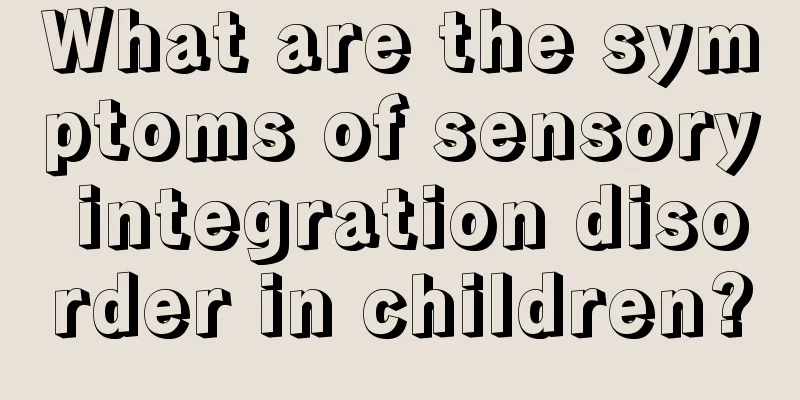What are the symptoms of sensory integration disorder in children?

|
Before the baby is born, the baby's sensory integration ability in the mother's belly is slowly developing. Everyone knows that before the age of six is a critical period for the development of a child's sensory integration ability. Generally speaking, babies with better sensory integration ability have better coordination and concentration, and are more receptive to new things. So what are the manifestations of sensory integration disorder in young children? Sensory Integration Disorder is not a disease Sensory integration disorder is not a disease. In fact, everyone has it, but the degree varies. Sensory integration disorder is generally divided into three degrees: mild, moderate, and severe. Many people still suffer from sensory integration disorder after they become adults. For example, they suffer from incoordination, motion sickness, and fear of heights. These are all manifestations of sensory integration disorder. Although sensory integration disorder is not a disease, it can hinder the development of children's concentration, learning ability, physical coordination, emotional control, interpersonal skills and other abilities. If they are not improved through targeted sensory integration training in a timely manner, I am afraid that children will encounter many difficulties in their future life and study. Regardless of whether your child has "sensory integration disorder", parents should not be too anxious. When you relax your mindset, you will be able to judge your child's condition more objectively and help your child train his or her sensory integration ability more rationally. Sensory integration disorder includes vision, hearing, touch and other aspects. When parents find that their children have the following problems, they should be vigilant and go to a professional children's hospital for evaluation first. Symptoms of sensory integration disorder in children : 1. Vestibular imbalance: manifested as poor self-control, restlessness, lack of concentration, petty movements, running around during breaks, provoking others, aggressive behavior, poor balance, falling when walking, lack of sense of direction, emotional instability, etc. Some children may also have delayed language development and difficulty expressing themselves. 2. Excessive tactile defense: dislike being touched by others, afraid of unfamiliar environments, unsociable, timid, withdrawn, poor social skills, nervous, withdrawn, bad temper, clingy, sucking fingers, biting nails, and even biting others; 3. Visual perceptual disorder: likes to watch TV but cannot read fluently, often misses words, writes slowly and untidyly, reverses strokes, copies wrong questions, writes wrong numbers, and makes frequent mistakes in calculations. 4. Auditory perception disorder: poor language expression, inability to fully describe a story, poor vocabulary, difficulty in forming words, sentences, and writing essays, etc. If the above symptoms occur, it is best to give them sensory integration training. It is not difficult at all to cultivate sensory integration ability. Sensory integration training games are sensory integration training in the form of games, which are more conducive to children's acceptance. Baby sensory training games 1. Swinging game: (0-1 years old) From the moment the baby is born, you have to start training the baby's sensory integration ability! As long as the elders in the family hold the baby in their arms and rock him gently, you can stimulate the vestibule, improve balance reaction, and increase muscle tension. When the baby is about one year old, you can find a large towel and place the child in the middle of the towel. Dad and mom each hold one side of the towel and gently rock the child. 2. Throwing and catching the ball: (from 1 to 3 years old) When the baby is one year old, you can put a rubber ball with a diameter of about 20 cm in front of the child and encourage the child to reach out and take the ball; When your baby is two years old, you can start playing advanced games. That is, use a 20-30 cm rubber ball, sit on the ground about two meters apart from your child, and play a passing game with your baby by rolling the ball. Babies can play advanced games when they are three years old. Increase the distance between you and your baby to 3 to 5 meters and pass the ball by bouncing. Training purpose: To improve the baby's hand-eye, bilateral, and visual tracking coordination. 3. Mirror game: (from 2 years old) From the age of two, your baby can start playing imitation games. By having children imitate their parents' actions, they can get to know their own bodies and distinguish between left and right. This will greatly improve their observation and movement planning abilities. However, don't make it too difficult at the beginning. Start with one hand and then progress to the whole body to prevent the movements from being too complicated and the baby from forgetting them and getting frustrated. |
<<: What is the reason for high lymphocyte count in children's blood routine test?
>>: What are the symptoms of vestibular dysfunction?
Recommend
What to do if your child's nose is always blocked
More and more people are suffering from rhinitis,...
How to prevent children's spring diarrhea
In fact, spring is a season for the growth of ger...
How to solve the problem of small blisters on children's fingers
Small blisters on children's fingers may be a...
When should children start having their vision checked?
Good eyesight affects a child's life, and wil...
Why do six-year-olds lose their teeth?
Some newborns will grow teeth slowly, and then re...
How to treat urinary tract infection in children?
Children are active individuals, but this activit...
Black spots on your child’s teeth?
Generally speaking, when babies start to grow tee...
How many months can a baby sit in a walker
When babies grow to a certain age, they will begi...
Baby yoga has so many benefits!
Nowadays, every family attaches great importance ...
What calcium supplement is good for a six-year-old child?
Many babies start taking various calcium suppleme...
What to do if your child has a toothache and a swollen face
For children, the most common cause of toothache ...
Two month old baby has yellow watery stool
If the stool of a two-month-old baby is yellow wa...
Solutions for children's hair loss
Recently, many children have had the problem of h...
What to do with pathological jaundice
My child is 3 years old. He has always been very ...
Signs of delayed development in girls
The characteristics of late development in girls ...









